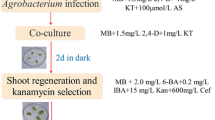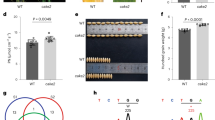Abstract
The lpa1 mutations in maize are caused by lesions in the ZmMRP4 (multidrug resistance-associated proteins 4) gene. In previous studies (Raboy et al. in Plant Physiol 124:355–368, 2000; Pilu et al. in Theor Appl Genet 107:980–987, 2003a; Shi et al. Nat Biotechnol 25:930–937, 2007), several mutations have been isolated in this locus causing a reduction of phytic acid (myo-inositol-1,2,3,4,5,6-hexakisphosphate, or InsP6) content and an equivalent increasing of free phosphate. In particular, the lpa1-241 mutation causes a reduction of up to 90% of phytic acid, associated with strong pleiotropic effects on the whole plant. In this work, we show, for the first time to our knowledge, an interaction between the accumulation of anthocyanin pigments in the kernel and the lpa mutations. In fact the lpa1-241 mutant accumulates a higher level of anthocyanins as compared to wild type either in the embryo (about 3.8-fold) or in the aleurone layer (about 0.3-fold) in a genotype able to accumulate anthocyanin. Furthermore, we demonstrate that these pigments are mislocalised in the cytoplasm, conferring a blue pigmentation of the scutellum, because of the neutral/basic pH of this cellular compartment. As a matter of fact, the propionate treatment, causing a specific acidification of the cytoplasm, restored the red pigmentation of the scutellum in the mutant and expression analysis showed a reduction of ZmMRP3 anthocyanins’ transporter gene expression. On the whole, these data strongly suggest a possible interaction between the lpa mutation and anthocyanin accumulation and compartmentalisation in the kernel.








Similar content being viewed by others
Abbreviations
- HIP:
-
High inorganic phosphate
- InsP:
-
myo-Inositol phosphates
- Lpa:
-
Low phytic acid
References
Astadi IR, Astuti M, Santoso U, Nugraheni PS (2009) In vitro antioxidant activity of anthocyanins of black soybean seed coat in human low density lipoprotein (LDL). Food Chem 112:659–663
Bogoslavsky L, Neumann PM (1998) Rapid regulation by acid pH of cell wall adjustment and leaf growth in maize plants responding to reversal of water stress. Plant Physiol 118:701–709
Bregitzer P, Raboy V (2006) Effects of four independent low-phytate mutations on barley agronomic performance. Crop Sci 46:1318–1322
Campion B, Sparvoli F, Doria E, Tagliabue G, Galasso I, Fileppi M, Bollini R, Nielsen E (2009) Isolation and characterisation of an lpa (low phytic acid) mutant in common bean (Phaseolus vulgaris L.). Theor Appl Genet 118:1211–1221
Chandler VL, Radicella JP, Robbins Chen JC, Turks D (1989) Two regulatory genes of the maize anthocyanin pathway are homologous: isolation of B utilizing R genomic sequences. Plant Cell 1:1175–1183
Chandler VL, Eggleston WB, Dorweiler JE (2000) Paramutation in maize. Plant Mol Biol 43:121–145
Chen PS, Toribara TY, Warner H (1956) Microdetermination of phosphorus. Anal Chem 28:1756–1758
de Vlaming P, Schram AW, Wiering H (1983) Genes affecting flower colour and pH of flower limb homogenates in Petunia hybrida. Theor Appl Genet 66:271–278
Dellaporta SL, Wood J, Hicks JB (1983) A plant DNA mini-preparation: Version II. Plant Mol Biol Rep 1:19–21
Dooner HK, Robbins TP, Jorgensen RA (1991) Genetic and developmental control of anthocyanin biosynthesis. Annu Rev Genet 25:173–199
Doria E, Galleschi L, Calucci L, Pinzino C, Pilu R, Cassani E, Nielsen E (2009) Phytic acid prevents oxidative stress in seeds: evidence from a maize (Zea mays L.) low phytic acid mutant. J Exp Bot 60:967–978
Goodman CD, Casati P, Walbot V (2004) A multidrug resistance-associated protein involved in anthocyanin transport in Zea mays. Plant Cell 16:1812–1826
Graf E, Eaton JW (1990) Antioxidant functions of phytic acid. Free Radic Biol Med 8:61–69
Graf E, Mahoney JR, Bryant RG, Eaton JW (1984) Iron-catalysed hydroxyl radical formation. J Biol Chem 259:3620–3624
Graf E, Epson KL, Eaton JW (1987) Phytic acid: a natural antioxidant. J Biol Chem 262:11647–11650
Guttieri M, Bowen D, Dorsch JA, Raboy V, Souza E (2004) Identification and characterization of a low phytic acid wheat. Crop Sci 44:418–424
Hitz WD, Carlson TJ, Kerr PS, Sebastian SA (2002) Biochemical and molecular characterization of a mutation that confers a decreased raffinosaccharide and phytic acid phenotype on soybean seeds. Plant Physiol 128:650–660
Hou DX, Fujii M, Terahara N, Yoshimoto M (2004) Molecular mechanisms behind the chemopreventive effects of anthocyanidins. J Biomed Biotechnol 5:321–325
Kania A, Langlade N, Martinoia E, Neumann G (2003) Phosphorus deficiency-induced modifications in citrate catabolism and in cytosolic pH as related to citrate exudation in cluster roots of white lupin. Plant Soil 248:117–127
Kermicle JL (1984) Recombination between components of a mutable gene system in maize. Genetics 107:489–500
Klein M, Burla B, Martinoia E (2006) The multidrug resistance-associated protein (MRP/ABCC) subfamily of ATP-binding cassette transporters in plants. FEBS Lett 580:1112–1122
Larson SR, Young KA, Cook A, Blake TK, Raboy V (1998) Linkage mapping of two mutations that reduce phytic acid content of barley grain. Theor Appl Genet 97:141–146
Larson SR, Rutger JN, Young KA, Raboy V (2000) Isolation and genetic mapping of a non-lethal rice (Oryza sativa L.) low phytic acid 1 mutation. Crop Sci 40:1397–1405
Liu K, Peterson KL, Raboy V (2007) Comparison of the phosphorus and mineral concentrations in bran and abraded kernel fractions of a normal barley (Hordeum vulgare) cultivar versus four low phytic acid isolines. J Agric Food Chem 55:4453–4460
O’Dell BL, de Boland AR, Koirtyohann SR (1972) Distribution of phytate and nutritionally important elements among the morphological components of cereal grains. J Agric Food Chem 20:718–721
Pascual-Teresa S, Santos-Buelga C, Rivas-Gonzalo JC (2002) LCMS analysis of anthocyanins from purple corn cob. J Sci Food Agric 82:1003–1006
Pilu R, Panzeri D, Gavazzi G, Rasmussen S, Consonni G, Nielsen E (2003a) Phenotypic, genetic and molecular characterization of a maize low phytic acid mutant (lpa241). Theor Appl Genet 107:980–987
Pilu R, Piazza P, Petroni K, Ronchi A, Martin C, Tonelli C (2003b) pl-bol3, a complex allele of the anthocyanin regulatory pl1 locus that arose in a naturally occurring maize population. Plant J 36:510–521
Pilu R, Landoni M, Cassani E, Doria E, Nielsen E (2005) The maize lpa241 mutation causes a remarkable variability of expression and some pleiotropic effects. Crop Sci 45:2096–2105
Pilu R, Panzeri D, Cassani E, Cerino Badone F, Landoni M, Nielsen E (2009) A paramutation phenomenon is involved in the genetics of maize low phytic acid1-241 (lpa1-241) trait. Heredity 102:236–245
Prior RL (2003) Fruits and vegetables in the prevention of cellular oxidative damage. Am J Clin Nutr 78:570S–578S
Raboy V (1990) The biochemistry and genetic of phytic acid synthesis. In: Morre DJ, Boss W, Loewus FA (eds) Inositol metabolism in plants. Alan R Liss, New York, pp 52–73
Raboy V (2002) Progress in breeding low phytate crops. J Nutr 132:503S–505S
Raboy V (2009) Approaches and challenges to engineering seed phytate and total phosphorus. Plant Sci 177:281–296
Raboy V, Gerbasi PF, Young KA, Stoneberg SD, Pickett SG, Bauman AT (2000) Origin and seed phenotype of maize low phytic acid 1-1 and low phytic acid 2-1. Plant Physiol 124:355–368
Raboy V, Young KA, Dorsch JA, Cook A (2001) Genetics and breeding of seed phosphorus and phytic acid. J Plant Physiol 158:489–497
Raina K, Rajamanickam S, Singh RP, Agarwal R (2008) Chemopreventive efficacy of inositol hexaphosphate against prostate tumor growth and progression in tramp mice. Clin Cancer Res 14:3177–3184
Rasmussen SK, Hatzack F (1998) Identification of two low-phytate barley (Hordeum vulgare L.) grain mutants by TLC and genetic analysis. Hereditas 129:107–112
Renaud S, de Lorgeril M (1992) Wine, alcohol, platelets, and the French paradox for coronary heart disease. Lancet 339:1523–1526
Seeram NP, Adams LS, Hardy ML, Heber D (2004) Total cranberry extract versus its phytochemical constituents: antiproliferative and synergistic effects against human tumor cell lines. J Agric Food Chem 52:2512–2517
Shi JR, Wang H, Hazebroek J, Ertl DS, Harp T (2005) The maize low-phytic acid 3 encodes a myo-inositol kinase that plays a role in phytic acid biosynthesis in developing seeds. Plant J 42:708–719
Shi JR, Wang HY, Schellin K, Li BL, Faller M, Stoop JM (2007) Embryo-specific silencing of a transporter reduces phytic acid content of maize and soybean seeds. Nat Biotechnol 25:930–937
Stevenson JM, Perera IY, Heilman I, Person S, Boss WF (2000) Inositol signaling and plant growth. Trends Plant Sci 5:252–258
Swarbreck D, Ripoll PJ, Brown DA, Edwards KJ, Theodoulou F (2003) Isolation and characterisation of two multidrug resistance associated protein genes from maize. Gene 315:153–164
Toufektsian MC, de Lorgeril M, Nagy N, Salen P, Donati MB, Giordano L, Mock HP, Peterek S, Matros A, Petroni K, Pilu R, Rotilio D, Tonelli C, de Leiris J, Boucher F, Martins C (2008) Chronic dietary intake of plant-derived anthocyanins protects the rat heart against ischemia–reperfusion injury. J Nutr 138:747–752
van Tunen AJ, Koes RE, Spelt CE, van der Kroll AR, Stuitje AR, Mol JNM (1988) Cloning of two chalcone flavanone isomerase genes from Petunia hybrida: coordinate, light regulated and differential expression of flavonoid genes. EMBO J 14:2350–2363
Vucenik I, Shamsuddin AM (2006) Protection against cancer by dietary IP6 and inositol. Nutr Cancer 55:109–125
Wilcox JR, Premachandra GS, Young KA, Raboy V (2000) Isolation of high seed inorganic P, low-phytate soybean mutants. Crop Sci 40:1601–1605
Winkel-Shirley B (2002) Biosynthesis of flavonoids and effects of stress. Curr Opin Plant Biol 5:218–223
Wright AD, Moehlenkamp CA, Perrot GH, Neuffer MG, Cone KC (1992) The maize auxotrophic mutant orange pericarp is defective in duplicate genes for tryptophan synthase. Plant Cell 4:711–719
Yoshida K, Kondo T, Okazaki Y, Katou K (1995) Cause of blue petal color. Nature 373:291
Yuan FJ, Zhao HJ, Ren XL, Zhu SL, Fu XJ, Shu QY (2007) Generation and characterization of two novel low phytate mutations in soybean (Glycine max L. Merr.). Theor Appl Genet 115:945–957
Acknowledgments
This work was supported by Fondo Interno Ricerca Scientifica e Tecnologica (F.I.R.S.T. 2007, 2008 and 2009 to R. Pilu). We wish to thank Dr. Victor Raboy, USDA ARS, Aberdeen, Idaho, USA, for his generous gift of lpa1-1 seeds, and Dr. Davide Reginelli for his hard work in the field.
Author information
Authors and Affiliations
Corresponding author
Additional information
F. Cerino Badone and E. Cassani contributed equally to this work.
Rights and permissions
About this article
Cite this article
Cerino Badone, F., Cassani, E., Landoni, M. et al. The low phytic acid1-241 (lpa1-241) maize mutation alters the accumulation of anthocyanin pigment in the kernel. Planta 231, 1189–1199 (2010). https://doi.org/10.1007/s00425-010-1123-z
Received:
Accepted:
Published:
Issue Date:
DOI: https://doi.org/10.1007/s00425-010-1123-z




